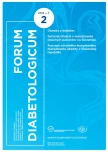Can bariatric surgery help in the treatment of obese type 2 diabetic patients?
Authors:
Pavol Holéczy 1,2; Marek Bužga 3
Authors‘ workplace:
Katedra chirurgických oborů, LF OU, Ostrava
1; Chirurgické oddělení, Vítkovická nemocnice, a. s., Ostrava-Vítkovice
2; Katedra fyziologie a patofyziologie LF OU, Ostrava
3
Published in:
Forum Diab 2018; 7(2): 117-121
Category:
Review Article
Overview
According to WHO data, adult obesity since 1976 has almost tripled to date. A similar trend can be observed in the pediatric population. It is shown that the most effective treatment of severe obesity is surgical treatment – bariatric / metabolic surgery. In addition to weight reduction, the attention of the obesitologic community is now focused on the positive effect of surgical intervention on comorbidity, particularly on type 2 diabetes mellitus. However, it is also important for other diseases that accompany severe obesity – arterial hypertension, sleep apnea syndrome, locomotive organs diseases and others. New criteria for bariatric /metabolic surgery have been defined, and diabetes association have included surgical treatment, for example, into a standard diabetes treatment algorithm. The authors describe the current trends in bariatric / metabolic surgery, the effect on co-morbidity, and in short they present newer surgical and endoscopic procedures.
Key words:
bariatric surgery, comorbidity, diabetes mellitus, endoscopy
Sources
- Obesity and overweight. WHO. Dostupné z WWW: <http://www.who.int/mediacentre/factsheets/fs311/en/>.
- Fried M, Yumuk V, Oppert JM et al. Interdisciplinárne európske záväzné odporúčania pre metabolickú a bariatrickú chirurgiu. Diabetes a Obezita 2014; 14(27): 113–122.
- 3.Global report on diabetes. WHO 2016. ISBN 978–92–4-156525–7. Dostupné z WWW: <http://apps.who.int/iris/bitstream/10665/204871/1/9789241565257_eng.pdf>.
- Buchwald H, VarcoL R. Metabolic surgery. Grune & Stratton: New York 1979. ISBN 978–0808910770.
- Buchwald H, Stoller DK, Campos CT et al. Partial ileal bypass for hypercholesterolemia. 20 - to 26-year follow-up of the first 57 consecutive cases. Ann Surg 1990; 212(3): 318–29; discussion 329–331.
- Pories WJ, Swanson MS, MacDonald KG et al. Who would have thought it? An operation proves to be the most effective therapy for adult-onset diabetes mellitus. Ann Surg 1995 ; 222(3): 339–350; discussion 350–352.
- Rubino F, Forgione A, Cummings DE et al. The Mechanism of Diabetes Control After Gastrointestinal Bypass Surgery Reveals a Role of the Proximal Small Intestine in the Pathophysiology of Type 2 Diabetes. Ann Surg 2006; 244(5):741–749. Dostupné z DOI: <http://dx.doi.org/10.1097/01.sla.0000224726.61448.1b>.
- Rubino F, Gagner M. Potential of Surgery for Curing Type 2 Diabetes Mellitus. Ann Surg 2002; 236(5): 554–559. Dostupné z DOI: <http://dx.doi.org/10.1097/01.SLA.0000032951.37471.80>.
- Farias MM, Cuevas AM, Rodriguez F. Set-Point Theory and Obesity. Metab Syndr Relat Disord 2011; 9(2): 85–89. Dostupné z DOI: <http://dx.doi.org/10.1089/met.2010.0090>.
- Rubino F, Nathan DM, Eckel RH et al. Metabolic Surgery in the Treatment Algorithm for Type 2 Diabetes: A Joint Statement by International Diabetes Organizations. Diabetes Care 2016; 39(6): 861–877. Dostupné z DOI: <http://dx.doi.org/10.2337/dc16–0236>.
- Standards of Medical Care in Diabetes 2017: Summary of Revisions. Diabetes Care 2017; 40(Suppl 1): S4-S5. Dostupné z DOI: <http://dx.doi.org/10.2337/dc17-S003>.
- Busetto L, Dixon J, De Luca et al. Bariatric surgery in class I obesity: a Position Statement from the International Federation for the Surgery of Obesity and Metabolic Disorders (IFSO). Obes Surg 2014; 24(4): 487–519. <http://dx.doi.org/10.1007/s11695–014–1214–1>.
- De Luca M, Angrisani L, Himpens J et al. Indications for Surgery for Obesity and Weight-Related Diseases: Position Statements from the International Federation for the Surgery of Obesity and Metabolic Disorders (IFSO). Obes Surg 2016; 26(8): 1659–1696.Dostupné z DOI: <http://dx.doi.org/10.1007/s11695–016–2271–4>.
- Schauer PR, Bhatt DL, Kirwan JP et al. Bariatric Surgery versus Intensive Medical Therapy for Diabetes — 5-Year Outcomes. N Engl J Med 2017; 376(7): 641–651. Dostupné z DOI: <http://dx.doi.org/10.1056/NEJMoa1600869>.
- Angrisani L, Santonicola A, Iovino P et al. Bariatric Surgery and Endoluminal Procedures: IFSO Worldwide Survey 2014. Obes Surg 2017; 27(9): 2279–2289. Dostupné z DOI: <http://dx.doi.org/10.1007/s11695–017–2666-x>. Erratum in Erratum to: Bariatric Surgery and Endoluminal Procedures: IFSO Worldwide Survey 2014.
- Fried M. Nové směřování chirurgické léčby obezity a některých metabolických onemocnění. Čas Lék Česk 2017; 156(6): 314–318.
- Melissas J, ErenTaskin H, Peirasmakis D et al. A Simple Food-Diverting Operation for Type 2 Diabetes Treatment. Preliminary Results in Humans with BMI 28–32 kg/m2. Obes Surg 2017; 27(1): 22–29. Dostupné z DOI: <http://dx.doi.org/10.1007/s11695–016–2251–8>.
- Fried M, Dolezalova K, Chambers AP et al. A novel approach to glycemic control in type 2 diabetes mellitus, partial jejunal diversion: pre-clinical to clinical pathway. BMJ Open Diabetes Res Care. 2017; 5(1): e000431. Dostupné z DOI: <http://dx.doi.org/10.1136/bmjdrc-2017–000431>.
- Machytka E, Bužga M, Zonča P et al. Partial jejunal diversion using an incisionless magnetic anastomosis system: 1-year interim results in patients with obesity and diabetes. Gastrointest Endosc 2017; 86(5): 904–912. Dostupné z DOI: <http://dx.doi.org/10.1016/j.gie.2017.07.009>.
- Haluzík M. Pohled diabetologa na metabolickou chirurgii v léčbě diabetiků 2. typu. AtheroRev 2017; 2(1): 25–31.
Labels
Diabetology Endocrinology Internal medicineArticle was published in
Forum Diabetologicum

2018 Issue 2
Most read in this issue
- Nonalcoholic fatty liver disease and metabolic syndrome
- The current situation in the management of obese patients in Slovakia: the concept of national comprehensive obesity management in the Slovak Republic
- Obesity paradox in patients with heart failure
- Can bariatric surgery help in the treatment of obese type 2 diabetic patients?
